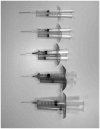Syringe and needle size, syringe type, vacuum generation, and needle control in aspiration procedures
- PMID: 21057795
- PMCID: PMC3638030
- DOI: 10.1007/s00270-010-0011-z
Syringe and needle size, syringe type, vacuum generation, and needle control in aspiration procedures
Abstract
Purpose: Syringes are used for diagnostic fluid aspiration and fine-needle aspiration biopsy in interventional procedures. We determined the benefits, disadvantages, and patient safety implications of syringe and needle size on vacuum generation, hand force requirements, biopsy/fluid yield, and needle control during aspiration procedures.
Materials and methods: Different sizes (1, 3, 5, 10, and 20 ml) of the conventional syringe and aspirating mechanical safety syringe, the reciprocating procedure device, were studied. Twenty operators performed aspiration procedures with the following outcomes measured: (1) vacuum (torr), (2) time to vacuum (s), (3) hand force to generate vacuum (torr-cm2), (4) operator difficulty during aspiration, (5) biopsy yield (mg), and (6) operator control of the needle tip position (mm).
Results: Vacuum increased tissue biopsy yield at all needle diameters (P<0.002). Twenty-milliliter syringes achieved a vacuum of -517 torr but required far more strength to aspirate, and resulted in significant loss of needle control (P<0.002). The 10-ml syringe generated only 15% less vacuum (-435 torr) than the 20-ml device and required much less hand strength. The mechanical syringe generated identical vacuum at all syringe sizes with less hand force (P<0.002) and provided significantly enhanced needle control (P<0.002).
Conclusions: To optimize patient safety and control of the needle, and to maximize fluid and tissue yield during aspiration procedures, a two-handed technique and the smallest syringe size adequate for the procedure should be used. If precise needle control or one-handed operation is required, a mechanical safety syringe should be considered.
Figures








Similar articles
-
Control and performance characteristics of eight different suction biopsy devices.J Vasc Interv Radiol. 2006 Oct;17(10):1657-69. doi: 10.1097/01.RVI.0000236837.47302.8E. J Vasc Interv Radiol. 2006. PMID: 17057008
-
Physician control of needle and syringe during aspiration-injection procedures with the new reciprocating syringe.J Rheumatol. 2006 Apr;33(4):771-8. Epub 2006 Mar 1. J Rheumatol. 2006. PMID: 16511940 Clinical Trial.
-
Fine needle biopsy without syringe aspiration.Cardiovasc Intervent Radiol. 1993 Jan-Feb;16(1):11-3. doi: 10.1007/BF02603030. Cardiovasc Intervent Radiol. 1993. PMID: 8435829
-
Comparative analysis of syringes versus pump devices in benchtop aspiration thrombectomy models: A systematic review and meta-analysis.Interv Neuroradiol. 2023 Dec 27:15910199231222305. doi: 10.1177/15910199231222305. Online ahead of print. Interv Neuroradiol. 2023. PMID: 38151033 Review.
-
Transbronchial biopsy and needle aspiration.Chest. 1989 May;95(5):1130-8. doi: 10.1378/chest.95.5.1130. Chest. 1989. PMID: 2651036 Review.
Cited by
-
Valveless On-Chip Aliquoting for Molecular Diagnosis.Micromachines (Basel). 2023 Jul 15;14(7):1425. doi: 10.3390/mi14071425. Micromachines (Basel). 2023. PMID: 37512736 Free PMC article.
-
Enhancing Efficiency in Meniscal Repair: A Novel In-House Vacuum Suction Technique for Suture Loading in Long Hollow Needles and Devices.Cureus. 2024 Oct 31;16(10):e72775. doi: 10.7759/cureus.72775. eCollection 2024 Oct. Cureus. 2024. PMID: 39618649 Free PMC article.
-
The diagnostic quality of needle brain biopsy specimens obtained with different sampling methods - Experimental study.Sci Rep. 2019 May 30;9(1):8077. doi: 10.1038/s41598-019-44622-4. Sci Rep. 2019. PMID: 31147596 Free PMC article.
-
Pars-plana fluid aspiration for positive vitreous cavity pressure in anterior segment surgeries.Indian J Ophthalmol. 2018 Apr;66(4):565-567. doi: 10.4103/ijo.IJO_939_17. Indian J Ophthalmol. 2018. PMID: 29582821 Free PMC article.
-
Comparison of outcomes of an 18-gauge vs 16-gauge ultrasound-guided percutaneous renal biopsy: a systematic review and meta-analysis.Ren Fail. 2023;45(2):2257806. doi: 10.1080/0886022X.2023.2257806. Epub 2023 Sep 19. Ren Fail. 2023. PMID: 37724553 Free PMC article.
References
-
- Tani E, Seregard S, Rupp G, Soderlund V, Skoog L. Fine-needle aspiration cytology and immunocytochemistry of orbital masses. Diagn Cytopathol. 2006;34:1–5. - PubMed
-
- Quinn SF, Nelson HA, Demlow TA. Thyroid biopsies: fine-needle aspiration biopsy versus spring-activated core biopsy needle in 102 patients. J Vasc Interv Radiol. 1994;5:619–623. - PubMed
-
- Althoff CE, Hermann KG, Wiechen K, et al. Formalin-fixed blood clots-- additional histological findings on computed tomography-guided fine-needle aspiration biopsies in comparison with core biopsies. J Comput Assist Tomogr. 2006;30:386–390. - PubMed
-
- Jain D. Diagnosis of hepatocellular carcinoma: fine needle aspiration cytology or needle core biopsy. J Clin Gastroenterol. 2002;35(5 Suppl 2):S101–108. - PubMed
Publication types
MeSH terms
Grants and funding
LinkOut - more resources
Full Text Sources
Other Literature Sources

